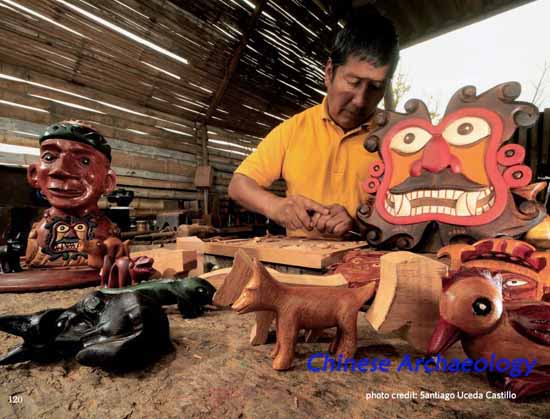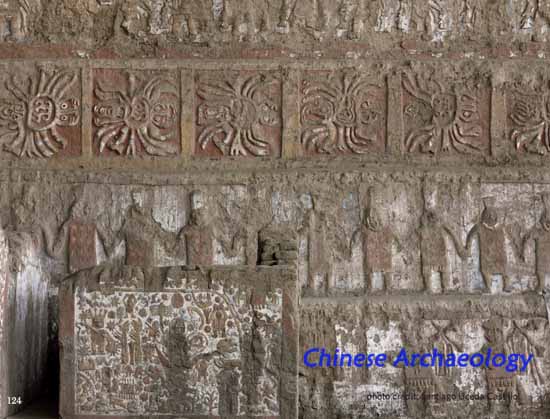Archaeological Investigation of the Temples of the Sun and Moon in Trujillo, Peru
The Huacas del Sol y de la Luna Archaeological Project (HSHLAP) is one of the largest archaeological research programs in Peru and the Americas since 1991, both in the scope of its objectives and in the range of its initiatives, from archaeological investigations and conservation programs to community outreach efforts. At the heart of the project is the Moche culture (ca. 100 – 800 AD) archeological complex in the coastal desert of northern Peru. The Moche developed the first state-level societies in the Central Andes, which occupies a large part of the desert located between the Pacific Ocean and the Andean mountains.
The archaeological complex comprises of two monumental public structures, the Huacas del Sol (sun) and de la Luna (moon), and an extensive urban sector in between the two, with houses, workshops, streets and open public areas. Huacas, or sacred loci, were the center of the ritual life of ancient Peruvian civilizations, and these two are among the largest in the entire continent.

The Huacas de Moche was subjected to severe plundering during the colonial era and were not investigated until 1899 when German archaeologist Max Uhle conducted stratigraphic excavations in the area. Uhle determined the major phases of occupation at the site, including the Moche, which predated the Incas, and established a horizonbased developmental sequence that remains fundamental to Andean chronology. In the 1920′s and 1930′s Rafael Larco Hoyle excavated a number of cemeteries at the site, which allowed him to identify a cultural sequence on the basis of ceramic seriation. It is not until the 1970′s that the site was again investigated. It was an archaeological megaproject organized by several American universities. Researchers defined the phases of construction, studied the nature of the residences in the urban sector, as well as local burial patterns. Beginning in 1991, a group of Peruvian researchers, led by Santiago Uceda and Ricardo Morales of the Universidad Nacional de Trujillo, began a long-term research, conservation and community outreach project. It has been twenty-two years of uninterrupted work. With sponsorships from private and public institutions and alliances formed between national and international educational institutions, a new cultural heritage management model in Peru has been developed.

The HSHLAP has adapted its aims and methods over the past twenty-two years to changes in the availability of resources and opportunities. However, at its core are three consistent goals: a) Multidisciplinary Archaeological Research; b) Conservation of the Monument and Archaeological Finds, and c) Community Development and Outreach Programs.
The primary objective of the HSHLAP is to understand the roles and characteristics of ritual and religious practices in the origins and development of the first state society in South America through the study of the Huacas de Moche religious center, whose significance is on a par with Teotihuacan in Mexico or Angkor Wat in Cambodia. As ritual spaces and urban/craft production settings were integrated at the HSHL, examining the ways in which religious and secular lives were intertwined is another main objective of the research project. The objectives have given rise to numerous research questions and each is addressed with a specific methodology and theoretical approach. Some of key issues are: (1) religious practices at the ceremonial centers of the site, particularly through it polychrome friezes, ritual performance, funerary practices, and human sacrifice, (2) establishing a detailed occupational sequence for the site and the region, particularly for the old temple of the Huaca de la Luna; (3) the social, political and economic organization of the urban sector; (4) the transformations of the ritual complex in the development of territorial states.

The discovery, excavation and conservation of polychrome friezes at Huaca de la Luna is the most notable archaeological contribution of the HSHLAP. Excavations have revealed 12,000 m2 of polychrome friezes (300-850 AD), the largest iconographic program ever excavated in South America. Themes revolve around the myths and ritual practices of the Moche. As these high-relieve friezes were undergoing excavation, their conservation became a paramount issue. The conservation of adobe architecture also requires innovative techniques. Hundreds of archaeologists and conservators, chemists, structural engineers, imaging experts, specialists in pigment, metals, ceramics and even charcoal, both Peruvians and foreign, participated in this research. During the excavations, human remains were uncovered in patios and plazas. Studies by bioarchaeologists, geneticists and pathologists concur that they were human sacrifices, which until then had only been known to us through visual representations on Moche ceramics. The bio-archaeological dimension of the project soon grew in importance. Excavations also took place in the areas surrounding the temples, where the general urban population had presumably lived. A 50-100 ha. residential area composed of 8 meters of superimposed occupational layers was uncovered in between the two large Huacas. The area is comprised of large residential districts, craft production workshops, water canals, streets and alleys. The urban sector of the HSHL site is unquestionably one of the earliest cities to be excavated in the New World. Urbanism, which arrived relatively late to the New World societies, seems to have been well-developed in the north coast of Peru.
In addition to its research and conservation efforts, the HSHLAP has focused its attention on a number of community development programs, which aim at transforming cultural heritage into cultural services and to improve the quality of life of the local populations. In order to meet this goal, we engage the local community through developing tourism and promoting visits to the archaeological site.
Santiago Uceda Castillo (Universidad Nacional de Trujillo)
Biographical Sketch
Santiago Uceda Castillo is Professor of Archaeology of the Faculty of Social Sciences, Universidad Nacional de Trujillo, Peru. He obtained his Ph.D. (1986) from Université de Bordeaux I, specializing in prehistory. Since 1991, he has served as co-director of the Huacas del Sol y de la Luna Archaeology Project. Among his research interests are complex societies in the Andes, particularly the Moche of Northern Peru, and lithic technology. He is the author or co-editor of numerous publications, including Moche; Propuestas y pespectivas (1994); Moche; Hacia el final del milenio (2003); and Moche, Pasado Presente y Futuro (2010). He has served as Department Chair and Dean of Social Sciences at the UNT, as well as Member of the Comision Nacional de Arqueologia at the Instituto Nacional de Cultura and President of Fomciencias. He is a member of the Society for American Archaeology, the History Academy of Peru, the German Archaeological Institute, and has received the French Government Order of Academic Palms. Dr. Uceda has participated in numerous international exhibitions devoted to pre-Columbian Art.

